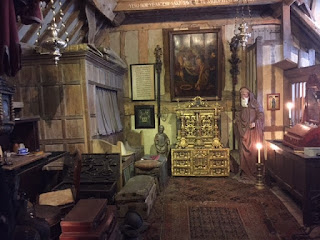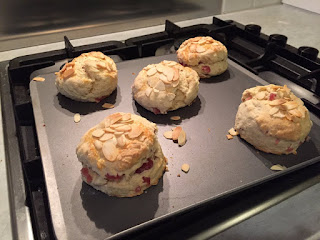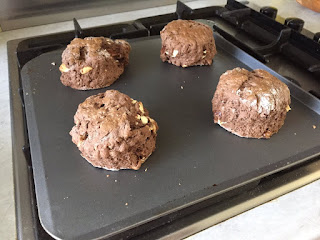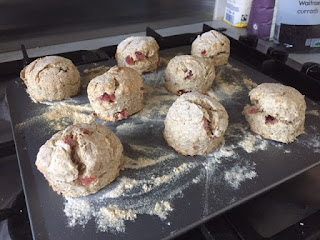Snowshill Manor is home to 22,000 objects collected by its former owner, Charles Wade. I initially felt an affinity with him, as I too have 22,000 objects in my home, collected by me.
However if the National Trust was to open my house to the public, they'd find that around 10,000 of those objects were little plastic bags containing a spare button that come attached to new clothes, and another 10,000 were hair bands that seem to be everywhere when I'm hoovering, but evaporate into thin air whenever I actually need a hair band.
The collection at Snowshill Manor doesn't include any such trivialities. I would say that, of all the NT properties I have been to, Snowshill is the hardest to put into words. But I will try.
Who was Charles Wade?
But then I decided he was actually Private Godfrey from Dad's Army; during the Second World War, Charles joined the Home Guard. He was much slower at marching than the others, but they charitably put that down to him having been in the Royal Engineers, who apparently marched at a slower pace. He also once asked to fire the platoon's Lewis gun but he fell over while he was trying to lie down to get in a shooting position and the gun went off into the sky. He resigned soon after.
My other favourite story was how he recruited his gardener: "to maintain his own authority and ownership he instead chose a hardworking man from among the builders, William Hodge, whose name and mauve hat were also to his liking."
What is there to see in the Manor?
I expected Snowshill Manor to be like an antiques shop - just loads of stuff thrown about. But it absolutely is not like that.
The first two rooms are quite misleading, in that they seem quite ordinary and sedate. But as you push on through the house, you find the most bizarre things, from a tableau of scary-looking samurai warriors to a room that is chock-full of bikes:
Where did Charles live?
Charles didn't live in the Manor - that was for his collections. He lived in the Priest's House opposite. Sometimes at the NT you see one room that sums up the person completely - maybe Rudyard Kipling's study at Bateman's or Vita Sackville West's study at Sissinghurst - and Chas's bedroom does exactly that. He definitely wasn't your typical 1920s landowner:
What was my favourite item in the Manor?
I read a pretty scathing TripAdvisor review before we went to Snowshill that said "it's just a load of tat". I quite like tat so I wasn't worried. But I warned the Scone Sidekick and said "if it's a bit boring, let's just pick our favourite thing?" I promptly forgot about this until he reminded me. I decided to go with these masks:
What was the Scone Sidekick's favourite item in the Manor?
It's funny the things that you discover about your loved ones. Today I found out that my partner of over ten years has a thing for sedan chairs. It's not a deal-breaker or anything, but it was a bit surprising.
Also - the person that wrote "it's just a load of tat" on TripAdvisor needs their head examined.
The Snowshill scone
But let's move on to the all-important scone. I had foolishly expected Snowshill to be quite quiet on a Thursday but it was absolutely heaving - a coach party pulled up just as we were arriving, forcing me and the Scone Sidekick to make like those racewalking athletes in the Olympics and waddle our way at speed down to the tea room.
The scone itself was tasty - maybe a little dry, but I ate it all and I enjoyed it.
I highly recommend Snowshill Manor. It's very, very unusual.
Snowshill Manor: 5 out of 5
Scone: 4.5 out of 5
Charles Wade's gardener recruitment criteria: 5 out of 5
Who was Charles Wade?
- Charles Paget Wade was an eccentric - it's the word that gets used over and over again about him in the book A Thousand Fancies
- He was born in 1883 to a family that owned sugar plantations on St Kitts
- His grandfather, Solomon, married Mary Jones, a black woman who had been born free rather than as a slave - she was believed to have been his housekeeper
- Their son, Paget, was born in the West Indies but the family moved back to the UK where Paget eventually met his wife, Amy, and they had Charles
- Charles hated school - he called them "factories of boredom" - and when he left he became an architect
- He had always loved well-designed and beautiful things and he began collecting - everything from weapons to costumes to carriages
- He was eventually called up to fight in World War I - while he was on the Western Front he saw Snowshill Manor advertised in Country Life magazine
- He bought Snowshill in 1919
- He turned the Manor House into a home for his collections
- Queen Mary came to visit and apparently said that the finest thing in his collection "was Mr Wade himself"
- Other visitors included Virginia Woolf, John Buchan, Graham Greene, and John Betjeman
At first, Charles reminded me of Catweazle - a wizard from a bygone era who somehow ended up in the 20th century. His eccentric hair and dress sense certainly set him apart from the crowd - apparently when he left the solicitor's office after buying Snowshill for £3,500, someone handed him the money for a cup of tea thinking he had fallen on hard times:
 |
| Charles Paget Wade. He was denounced as "a fraud" by Virginia Woolf, because she said he pretended not to have a watch and she missed her train |
My other favourite story was how he recruited his gardener: "to maintain his own authority and ownership he instead chose a hardworking man from among the builders, William Hodge, whose name and mauve hat were also to his liking."
What is there to see in the Manor?
I expected Snowshill Manor to be like an antiques shop - just loads of stuff thrown about. But it absolutely is not like that.
The first two rooms are quite misleading, in that they seem quite ordinary and sedate. But as you push on through the house, you find the most bizarre things, from a tableau of scary-looking samurai warriors to a room that is chock-full of bikes:
 |
| Try winning the Tour de France on one of these, Chris Froome |
Charles didn't live in the Manor - that was for his collections. He lived in the Priest's House opposite. Sometimes at the NT you see one room that sums up the person completely - maybe Rudyard Kipling's study at Bateman's or Vita Sackville West's study at Sissinghurst - and Chas's bedroom does exactly that. He definitely wasn't your typical 1920s landowner:
 |
| The panelled 'box' on the left that looks like something from a crematorium was Charles' bed - I'm not sure I'd have slept well in it but each to their own |
I read a pretty scathing TripAdvisor review before we went to Snowshill that said "it's just a load of tat". I quite like tat so I wasn't worried. But I warned the Scone Sidekick and said "if it's a bit boring, let's just pick our favourite thing?" I promptly forgot about this until he reminded me. I decided to go with these masks:
What was the Scone Sidekick's favourite item in the Manor?
It's funny the things that you discover about your loved ones. Today I found out that my partner of over ten years has a thing for sedan chairs. It's not a deal-breaker or anything, but it was a bit surprising.
Also - the person that wrote "it's just a load of tat" on TripAdvisor needs their head examined.
The Snowshill scone
But let's move on to the all-important scone. I had foolishly expected Snowshill to be quite quiet on a Thursday but it was absolutely heaving - a coach party pulled up just as we were arriving, forcing me and the Scone Sidekick to make like those racewalking athletes in the Olympics and waddle our way at speed down to the tea room.
The scone itself was tasty - maybe a little dry, but I ate it all and I enjoyed it.
I highly recommend Snowshill Manor. It's very, very unusual.
Snowshill Manor: 5 out of 5
Scone: 4.5 out of 5
Charles Wade's gardener recruitment criteria: 5 out of 5
























